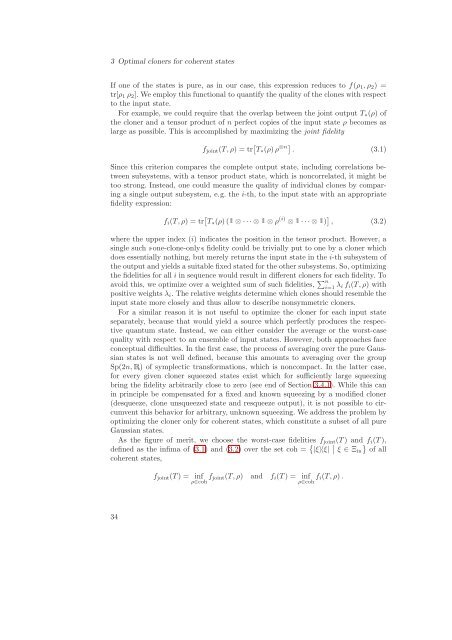Quantum Information Theory with Gaussian Systems
Quantum Information Theory with Gaussian Systems
Quantum Information Theory with Gaussian Systems
Create successful ePaper yourself
Turn your PDF publications into a flip-book with our unique Google optimized e-Paper software.
3 Optimal cloners for coherent states<br />
If one of the states is pure, as in our case, this expression reduces to f(ρ1, ρ2) =<br />
tr[ρ1 ρ2]. We employ this functional to quantify the quality of the clones <strong>with</strong> respect<br />
to the input state.<br />
For example, we could require that the overlap between the joint output T∗(ρ) of<br />
the cloner and a tensor product of n perfect copies of the input state ρ becomes as<br />
large as possible. This is accomplished by maximizing the joint fidelity<br />
fjoint(T, ρ) = tr T∗(ρ)ρ ⊗n . (3.1)<br />
Since this criterion compares the complete output state, including correlations between<br />
subsystems, <strong>with</strong> a tensor product state, which is noncorrelated, it might be<br />
too strong. Instead, one could measure the quality of individual clones by comparing<br />
a single output subsystem, e.g. the i-th, to the input state <strong>with</strong> an appropriate<br />
fidelity expression:<br />
fi(T, ρ) = tr T∗(ρ)( ⊗ · · · ⊗ ⊗ ρ (i) ⊗ · · · ⊗ ) , (3.2)<br />
where the upper index (i) indicates the position in the tensor product. However, a<br />
single suchone-clone-onlyfidelity could be trivially put to one by a cloner which<br />
does essentially nothing, but merely returns the input state in the i-th subsystem of<br />
the output and yields a suitable fixed stated for the other subsystems. So, optimizing<br />
the fidelities for all i in sequence would result in different cloners for each fidelity. To<br />
avoid this, we optimize over a weighted sum of such fidelities, n i=1 λi fi(T, ρ) <strong>with</strong><br />
positive weights λi. The relative weights determine which clones should resemble the<br />
input state more closely and thus allow to describe nonsymmetric cloners.<br />
For a similar reason it is not useful to optimize the cloner for each input state<br />
separately, because that would yield a source which perfectly produces the respective<br />
quantum state. Instead, we can either consider the average or the worst-case<br />
quality <strong>with</strong> respect to an ensemble of input states. However, both approaches face<br />
conceptual difficulties. In the first case, the process of averaging over the pure <strong>Gaussian</strong><br />
states is not well defined, because this amounts to averaging over the group<br />
Sp(2n,Ê) of symplectic transformations, which is noncompact. In the latter case,<br />
for every given cloner squeezed states exist which for sufficiently large squeezing<br />
bring the fidelity arbitrarily close to zero (see end of Section 3.4.1). While this can<br />
in principle be compensated for a fixed and known squeezing by a modified cloner<br />
(desqueeze, clone unsqueezed state and resqueeze output), it is not possible to circumvent<br />
this behavior for arbitrary, unknown squeezing. We address the problem by<br />
optimizing the cloner only for coherent states, which constitute a subset of all pure<br />
<strong>Gaussian</strong> states.<br />
As the figure of merit, we choose the worst-case fidelities fjoint(T) and fi(T),<br />
defined as the infima of (3.1) and (3.2) over the set coh = |ξ〉〈ξ| <br />
ξ ∈ Ξin of all<br />
coherent states,<br />
34<br />
fjoint(T) = inf<br />
ρ∈coh fjoint(T, ρ) and fi(T) = inf<br />
ρ∈coh fi(T, ρ).
















